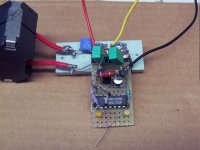Kenshin said:How many components would that need?
Stripped down to its most basic state, my 6th order ADC circuit has 170 parts: 2 quad opamps, 1 double and 2 singles, a comparator, a handful of logic chips and a whole sprinkling of passives.
http://www.grimmaudio.com/images/admodule.jpg
(It pays off tho. Full scale THD=-129dB, all freqs)
has 170 parts
The purists wouldn't like that especially the amount of op-amps. 😉
Looks very nice BTW. Just out of curiosity: What is the price of such a converter ? How does it compare (sonically) to the usual 5th order converter as proposed by Sony ?
Regards
Charles
The circuit is balanced, so we're talking about only 6 op-amps 😀.phase_accurate said:The purists wouldn't like that especially the amount of op-amps. 😉
They're all inside the loop. The input signal is fed to the summing node through only 2 resistors.
Other deltasigma ADCs have an equal number of op-amps in the loop, except that they're invisible (inside a monolithic chip). Furthermore, the switch-cap topology of monolithic ADC's requires a buffer in the input which my continuous-time circuit doesn't. In other words, I've got a much more purist design, with much less in the signal path outside the loop.
Depends what you mean. We only sell complete converter systems, not the subcircuit. An 8-channel Grimm Audio AD1 weighs in at around 12k euros EUP.phase_accurate said:Just out of curiosity: What is the price of such a converter ?
The Sony circuit refers only to a given modulator topology and coefficients, not to a specific implementation (it doesn't even say whether it's a digital or an analogue modulator), so to make a sonic comparison is not relevant. To give an idea of "sound", we've had demos in studios where the engineers started tracing the cables to check if the signal was really going through the converters...phase_accurate said:How does it compare (sonically) to the usual 5th order converter as proposed by Sony ?
See AES ppt 5823, "Design Techniques for High-performance Discrete A/D Converters" for info on how the circuit works.
This seems to be a really cool converter indeed ! I always like topologies where the active gain stages are within the forward path only.
What D/A converter was used ?
Regards
Charles
To give an idea of "sound", we've had demos in studios where the engineers started tracing the cables to check if the signal was really going through the converters...
What D/A converter was used ?
Regards
Charles
About the "idle tone" problem: I am currently doing an analysis of that effect. My theory is that they are caused by what is called "subharmonic oscillation", something known to exist in higly nonlinear systems. And in a sigma-delta-converter, the comparator is a highly nonlinear thing (in the small-signal point of view, it is always in saturation). The problem is that most of the methods dealing with this effect are just for analysing and not for deriving design tips. I might be totally wrong with that approach, but i give it a chance since what i experienced reminded me of typical sub/superharmonic oscillation scenario.
digi
digi
Is it possible/good to do it with CD4069 CMOS hex inverter instead of OPAMP?
Bruno Putzeys said:
Stripped down to its most basic state, my 6th order ADC circuit has 170 parts: 2 quad opamps, 1 double and 2 singles, a comparator, a handful of logic chips and a whole sprinkling of passives.
http://www.grimmaudio.com/images/admodule.jpg
(It pays off tho. Full scale THD=-129dB, all freqs)
It should theoretically be possible to make an experimental d-s modulator with those but don't expect high-end performnance.
Regards
Charles
Regards
Charles
I tried this some time ago, to see if it's possible to make a good simple el-cheapo Class D.
It sounds ok, and it works fine BUT it makes ugly noises at start, stop and clipping. And it has too much DC out.
Can be fixed of course, but after that you will have the same price as the usual setup with opamp integrator, comparator, gate driver etc. So it's not worthwhile.
No matter which modulator and driver you use, the choke, mosfet's, PCB, assembly and power lytics still cost the same...
It sounds ok, and it works fine BUT it makes ugly noises at start, stop and clipping. And it has too much DC out.
Can be fixed of course, but after that you will have the same price as the usual setup with opamp integrator, comparator, gate driver etc. So it's not worthwhile.
No matter which modulator and driver you use, the choke, mosfet's, PCB, assembly and power lytics still cost the same...
Attachments
At Philips we had a chap in Vienna who did everything with 4069 chips, including, at one time, a class D amp which even went into a product. Performance was shameful, especially noise, but it worked. Many of the cheaper Philips micro systems were built using 4069 from the ground up.
- Status
- Not open for further replies.
- Home
- Amplifiers
- Class D
- Nth Order Sigma-Delta
